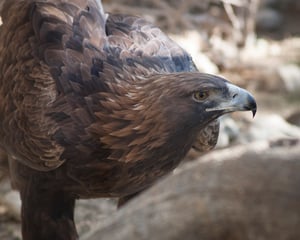
As I study the bird feeders in my backyard this spring, I find myself marveling at the variety of patterns that feathers allow. Stripes, patches, streaks, colors, and mottles: these are the details birders use to differentiate the many bird varieties that don’t have other telltale physical attributes. Although we appreciate them for advertising a bird’s species, sex, and health, feathers are so much more.
Feathers likely are the most versatile structure that has ever evolved. They shield their wearers from sun and rain, stymie pests, and serve as sleek airfoils to make flight possible. They hold up to constant scraping from tree branches, thorns and nasty weather but are the archetype for lightness. They insulate better than fur and make flight so efficient that any bat would covet them. Their form and function are an evolutionary wonder, yet, this time of year, I’m thinking most about color.
In April, the scenes at my backyard bird feeders got a lot more yellow and red. The goldfinches, evening grosbeaks, and house finches all of a sudden seemed a lot more perceptible. Bright colors and patterns in males stem from this basic premise: females are choosy. Females get to pick their mates, and most evolutionary biologists theorize that bright colors signal health and foraging ability to the female who wants to pass on the best genes possible to her chicks. The downside is being easier to spot by predators, but the rewards have outweighed the risks, evolutionarily speaking, and color displays aren’t leaving the avian world
anytime soon.
Feather color can come from pigment or structure. Many birds can manufacture their own pigments, such as the melanin in a song sparrow or a crow. Melanin is the same pigment that darkens human hair and shades our skin, and is commonly used as camouflage. Reds, yellows and oranges, however, come from carotenoids and must be eaten as part of a bird’s diet to produce color. Still other feather color is structural; the mesmerizing iridescence of a hummingbird throat and the brilliant blue of a Steller’s jay result from how light reflects off the structure of the protein in their feather barbules. Turns out, blue feathers aren’t blue; they are
just optical illusions.
With all of the showy displays going on in my backyard these days, I find myself wondering more and more about the LBBs, or Little Brown Birds that don’t usually get much of our attention. Even these species have evolved deliberate patterns, markings and shades over thousands of years to best suit them for camouflage in their specific habitat. Last week, while eating dinner on my back porch, a pine siskin casually hopped into my living room. My husband and I searched for it for an hour, combing through our house plants and checking every room until we decided that it hadn’t happened; the bird must not have gone inside. An hour later and what do you know? We saw her hop from one potted plant to another - she had been there the whole time. What is not to admire about a bird so perfectly feathered that she cannot be found?
Hannah Rumble is the Community Programs Director at Walking Mountains Science Center. Her favorite bird changes from day to day, since they’re all pretty great.









